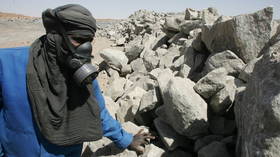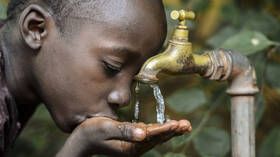Africa’s secret weapon: Extracting this resource will help present the continent’s true potential to the world

In recent years, Africa’s mineral resources have been primarily associated with cobalt, tantalum, platinum, manganese, and other ‘critical minerals’. Critical minerals are relatively rare earth elements which are essential components in clean energy technologies and the transition from fossil fuels to renewable energy sources. Today, critical minerals often overshadow traditional energy sources such as oil, gas, coal, and uranium.
Uranium in Africa and its significance
Oil, gas, and coal have been extracted in Africa for over 100 years, and the major deposits have been explored, developed, and mined. However, with uranium, things are quite different.
Firstly, Africa’s uranium reserves have not been thoroughly explored. Secondly, due to the global energy crisis, the demand for nuclear energy is growing, and this guarantees long-term demand for uranium. As of November 2023, around 60 nuclear reactors are being built around the world, and 14 of them are set to enter commercial operation in 2024.
Finally, the EU Taxonomy for Sustainable Activities – the European Commission’s primary governing document on energy resources – has (with certain exceptions) classified uranium as climate-friendly, and this will help attract investments from Western companies and financial institutions, as well as non-Western structures oriented towards Western evaluation criteria and expertise.
2023 could be called the year of uranium in Africa. Global uranium markets have recovered from a decade-long crisis – brought on by the 2011 accident at Japan’s Fukushima Nuclear Power Plant – and the uranium spot price rose from $30-$40 per pound to $70. The price increase allowed many projects that had been mothballed in the past decade to be resumed. For example, in Namibia, two uranium mining licenses were obtained in December 2023. Projects related to uranium exploration and production are also being launched in Tanzania, Niger, and other African countries.
The uranium issue often came up during discussions of the coup d’état that took place in Niger in July 2023. The coup led to the expulsion of French troops and the French ambassador from Niger, as well as interruptions in uranium shipments from Niger to France. However, the assets of the French nuclear energy company Orano were not nationalized – France still receives up to 30% of its annual consumption of uranium from Niger through the port of Cotonou in Benin. Despite certain problems with logistics, the Orano mines continue to operate.
Africa’s place in world uranium markets
According to the Organization for Economic Co-operation and Development (OECD) and the International Atomic Energy Agency (IAEA), African countries account for 22% of the world’s recoverable identified uranium resources (1.3 million tons of uranium). Most of the uranium reserves are located in Namibia, Niger, and South Africa. Uranium has also been discovered in Botswana, Tanzania, Zambia, Mauritania, Malawi, Mali, Gabon, and Egypt.
African countries have always been important for the world’s nuclear industry. The Democratic Republic of the Congo (DRC) was one of the first countries in the world to mine uranium – at the Shinkolobwe mine in Haut-Katanga province. These reserves were discovered by the Belgian mining company Union Miniere du Haut-Katanga (UMHK) in 1915, and mining started in 1921.
Before the start of WWII, uranium from the DRC was shipped to Belgium, which was once the world’s largest radium producer. During the war, the United States used uranium from Shinkolobwe for the Manhattan Project – the US nuclear weapon program during WWII – and the creation of atomic weapons. Between the 1940s and 60s, the DRC accounted for around 60% of the global uranium market. When the country gained independence in 1960, Belgium sealed the Shinkolobwe underground mine by pouring concrete over its main entrance and flooding the mine. Since then, commercial production has been discontinued.
In parallel, uranium was mined in Namibia and South Africa. Western countries played an important role in the development of the uranium mining industry in South Africa during the apartheid regime.
In 1980, in the context of the Cold War, uranium production surged to 70,000 tons, and Africa accounted for 21% of it; 15% was mined in South Africa and Namibia – which was then occupied by South Africa – for the needs of the South African nuclear program. Uranium was also supplied to the UK, Israel, Japan, and other Western countries. Another 6% was mined in Niger for the needs of France. Since then, Africa’s share of global uranium production has not changed much.
In 2022, 7,800 tons of uranium (16% of the global production volume) were mined in Africa, which is about the same as in Canada. Only three African countries are involved in the industrial production of uranium – Namibia (5,600 tons), Niger (2,000 tons), and South Africa (0.2 tons). Mining in Malawi stopped in 2014 due to falling uranium prices, and in the DRC, only some makeshift mines have remained (people can buy a couple of grams of uranium from the DRC at mineral marketplaces).
Tanzania is about to start mining uranium as part of the Mkuju River project run by Uranium One – a subsidiary of the Russian State Nuclear Energy Corporation Rosatom.
There has been a lot of media speculation about other countries joining the producers’ club. Several African countries – Zimbabwe, Mali, and the Central African Republic – have been sustaining hopes of launching uranium production for over half a century (reserves have been discovered, but extraction is not economical). However, the media continues to speak about the enormous reserves in Africa.
Another popular theme is Iran. Rumor has it that Tehran is interested in every single uranium mining project out there. Nevertheless, the only evidence of Iran’s involvement in uranium mining in Africa is its 15% stake (via the Iranian Foreign Investment Company) in the Rössing Uranium Mine in Namibia, acquired in 1975 by the then-Shah of Iran.
Africa ships uranium mostly to Europe and North America, and about a third of it is shipped to Asia, mainly to China. The geography has not changed much over the years.
Over the past decade, Africa’s uranium industry has undergone major changes. On the one hand, due to falling uranium prices, almost a dozen mining projects – in Namibia, Niger, Tanzania – were mothballed. On the other hand, Chinese energy companies continued to expand – a process that started in 2007, when the China National Nuclear Corporation (CNNC) bought a stake in the Azelik Mine in Niger. In the 2010s, Chinese companies bought stakes in two of the largest mines in Namibia – the China General Nuclear Power Group (CGN) bought a stake in the Husab mine, and CNNC bought a stake in the Rössing Mine.
Due to rising uranium prices, in the coming years, an increase in uranium production in Africa – primarily in Namibia but also in Niger and Tanzania – as well as increased interest in exploration projects can be expected.
Why does Africa need uranium?
Although Africa accounts for 16% of world uranium production, the only operating nuclear power plant (NPP) in the region is the Koeberg Nuclear Power Station in South Africa. It has a capacity of 1,880 MW, and annually consumes around 300 tons of uranium in the form of nuclear fuel (about 0.6% of the world production volume). However, it depends on nuclear fuel supplies from the US Westinghouse corporation. Meanwhile, fuel for the El Dabaa NPP in Egypt (4,800 MW), which is being built by Rosatom, will be supplied by the Russian energy company.
So far, the uranium fuel market in Africa is poorly developed due to the lack of major consumers (just one nuclear power plant and several research reactors). The global nuclear fuel market is divided between several large corporations: Orano (France), GNF (US-Japan), TVEL (Russia), and Westinghouse (US). Nuclear fuel production is a high-tech process that requires significant investments in infrastructure, related enterprises, personnel training, etc., so in the long term, it is unlikely that it will be localized in Africa. An increase in uranium consumption within Africa is also unlikely.
In Africa, and especially in sub-Saharan Africa, few countries have the tens of billions of dollars necessary to build NPPs. Moreover, many African countries depend on loans from the World Bank and the IMF, and these organizations promote renewable energy solutions inspired by their stakeholders. There are also other challenges related to the construction of NPPs in Africa, such as the insufficient development of electrical grid infrastructure, security risks, a shortage of personnel, and problems with the regulatory framework.
In the future, uranium mining may contribute to the development of the nuclear sector. It will help with the regulatory framework, allow contacts to be established with the IAEA and influential players in the global nuclear technology market, and help form an employee base. This way, the next step may be the construction of nuclear research reactors and then nuclear power plants.
For many African countries, the trade deficit, which is covered by loans or gold reserves, is one of the major challenges preventing economic development. Considering the high market prices, uranium exports will reduce this deficit and will help replenish the budget through taxes and royalties. For example, uranium exports account for up to 30% of Niger’s and 14% of Namibia’s export revenues.
Uranium mining requires large amounts of money, sometimes billions of dollars. Financing is necessary not only for the construction of mining and processing plants and other mining infrastructure, but also for transport infrastructure, water pipelines, and supporting local communities. For example, in 2010, a desalination plant with an annual production capacity of 26,000 cubic meters was built in Namibia for the Trekkopje Mine. Despite the fact that the launch of the mine has been postponed, fresh water is being supplied to Swakopmund and other cities in the Erongo Region, which has greatly contributed to solving the region’s water supply problems.
***
The uranium mining industry in Africa needs to maintain a balance between producing ‘local content’ and keeping the industry attractive for foreign investors. African countries also need to diversify external partnerships in order to be less dependent on foreign policy changes. A competent and well-thought-out policy will ensure the rapid development of many African regions.
The global energy crisis has once again transformed global markets. Clearly, the world still needs stable power generation which does not depend on the Sun, wind, and droughts. Coal, which used to ensure the base load of an electrical grid, is now considered harmful to the ecology, while gas is highly susceptible to price fluctuations and dependence on gas imports makes it an unreliable energy source. In this context, the growing demand for uranium and the increasing market competition (including in Africa) are inevitable consequences, which means that uranium will become an important topic both in African and world politics.















